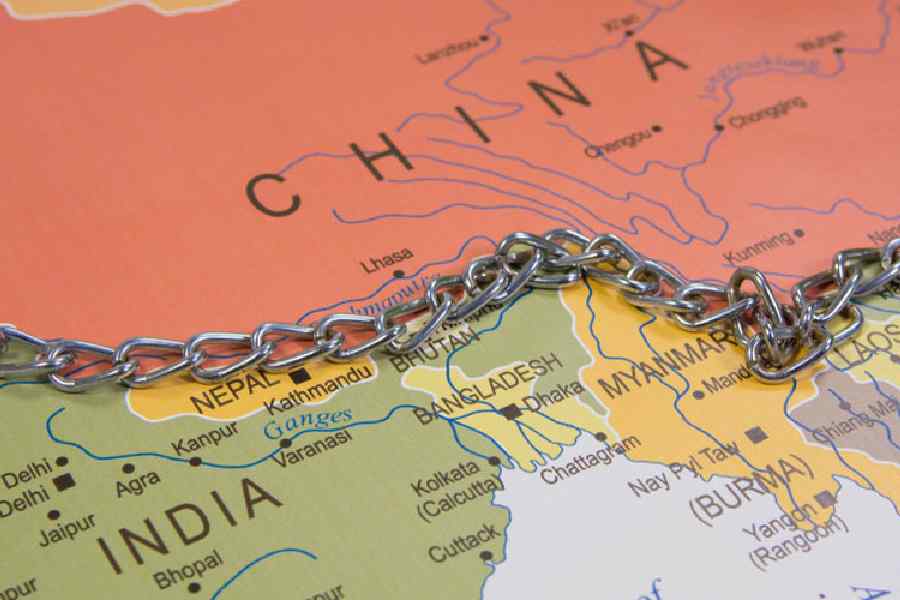Qionglin New Village sits deep in the Himalayas, just 5km from a region where a heavy military buildup and confrontations between Chinese and Indian troops have brought fears of a border war.
The land was once an empty valley, more than 10,000 feet above the sea, traversed only by local hunters. Then Chinese officials built Qionglin, a village of cookie-cutter homes and finely paved roads, and paid people to move there from other
settlements.
China’s leader, Xi Jinping, calls such people “border guardians”. Qionglin’s villagers are essentially sentries on the front line of China’s claim to Arunachal Pradesh, which Beijing insists is part of Chinese-ruled Tibet.
Many villages like Qionglin have sprung up. In China’s west, they give its sovereignty a new, undeniable permanence along boundaries contested by India, Bhutan and Nepal. In its north, the settlements bolster security and promote trade with Central Asia. In the south, they guard against the flow of drugs and crime from Southeast Asia.
The buildup is the clearest sign that Xi is using civilian settlements to
quietly solidify China’s control in far-flung frontiers, just as he has with fishing militias and islands in the disputed South China Sea.
The New York Times mapped and analysed settlements along China’s border to create the first detailed visual representation of how the country has reshaped its frontiers with strategic civilian outposts, in just eight years.
Working with the artificial intelligence company RAIC Labs, which scanned satellite images of China’s entire land border captured by Planet Labs, The Times identified the locations of new villages and checked them against historical images, state media, social media posts and public records.
The mapping reveals that China has put at least one village near every accessible Himalayan pass that borders India, as well as on most of the passes bordering Bhutan and Nepal, according to Matthew Akester, an independent researcher on Tibet, and Robert Barnett, a professor from SOAS University of London. Akester and Barnett, who have studied Tibet’s border villages for years, reviewed The Times’s findings.
The outposts are civilian in nature, but they also provide China’s military with roads, access to the Internet and power should it want to move troops quickly to the border. Villagers serve as eyes and ears in remote areas, discouraging intruders or runaways.
“China does not want outsiders to be able to walk across the border for any distance without being challenged by its security personnel or citizens,” Akester said.
The buildup of settlements fuels anxiety in the region about Beijing’s ambitions. The threat of conflict is ever present: Deadly clashes have broken out along the border between troops from India and China since 2020, and tens of thousands of soldiers from both sides remain on a war footing.
Eyes and ears
The first signs of Xi’s ambitions emerged in 2017, when state media told the story of a letter he wrote to two Tibetan sisters in the remote village of Yume, in a region near Arunachal Pradesh that is blanketed by deep snow for more than half the year.
Xi praised their family for having protected the area for China for decades, despite the inhospitable terrain: “I hope you continue your spirit as a patriot and border guardian.”
Over the next few years, workers built dozens of new homes in Yume, and officials moved over 200 people there.
Yume, also known as Yumai in Chinese, is among at least 90 new villages and expanded settlements that have sprung up in Tibet since 2016, when China began outlining its border village plan in the region, The Times found.
In neighbouring Xinjiang and Yunnan, The Times identified 6 new and 59 expanded border villages. (China says there are hundreds of villages like them, but few details are available and many appear to be mere upgrades of existing villages.)
Of the new villages The Times identified in Tibet, one is on land claimed by India, though within China’s de facto border; 11 other settlements are in areas contested by Bhutan. Some of those 11 villages are near the Doklam region, the site of a standoff between troops from India and China in 2017 over Chinese attempts to extend a road.
China makes clear that the villages are there for security. In 2020, a leader of a Tibetan border county told state media that he was relocating more than 3,000 people to frontier areas that were “weakly controlled, disputed or empty”.
Brahma Chellaney, a strategic affairs analyst based in New Delhi, said that in quietly building militarised villages in disputed borderlands, China was replicating on land an expansionist approach that it had used successfully in the South China Sea.
“What stands out is the speed and stealth with which China is redrawing facts on the ground, with little regard for the geopolitical fallout,” Chellaney said. “China has been planting settlers in whole new stretches of the Himalayan frontier with India and making them its first line of defence.”
In a written response to The Times, Liu Pengyu, a spokesman for the Chinese embassy in Washington, said that in dealing with border issues with its neighbours, “China always strives to find fair and reasonable solutions through peaceful and friendly consultations.”
India and Bhutan did not respond to requests for comment about the buildup. Indian officials have previously noted “infrastructure construction activity” by China along the border. Local leaders in Arunachal Pradesh and Ladakh have complained to The Times that China is slowly cutting away small pieces of Indian territory.
India has responded with what it calls “Vibrant Villages”, a campaign that aims to revive hundreds of villages along the border.
But China is outbuilding India, says Brian Hart, an analyst for the China Power Project at the Centre for Strategic and International Studies, or CSIS, who recently co-authored a report on border villages in Tibet.
Among other findings, the CSIS report identified what appeared to be a militarised facility in one such village, known as Migyitun, or Zhari in Chinese, an indication of the settlements’ dual-use nature. The Times studied satellite images of the same village and identified military trucks and tents, as well as what appeared to be a shooting range nearby.
The villages also serve as propaganda: a display of Chinese strength and superiority in the region, said Jing Qian, co-founder of the Center for China Analysis at the Asia Society.
“They want the Indians, Central Asians and others to see and think that Chinese villages are so good, that the China model is working very well.”
Unforgiving terrain
The slice of the Himalayas where many Chinese villages have sprung up has been largely uninhabited for good reason. Its rocky, icy terrain is particularly forbidding in winter, with roads buried many months of the year by deep snow. The air is thin and cold. The land is barren, making farming difficult.
To persuade residents to move there, Chinese Communist Party officials promised them their new homes would be cheap. They would receive annual subsidies and get paid extra if they took part in border patrols. Chinese propaganda outlets said the government would provide jobs and help promote local businesses and tourism. The villages would come with paved roads, Internet connections, schools and clinics.
A local government document reviewed by The Times indicated that some villagers may be receiving around 20,000 Chinese yuans a year for relocation, less than $3,000. One resident reached by phone said he earned an extra $250 a month by patrolling the border.
But it is unclear whether the villages make economic sense.
The residents become dependent on the subsidies because there are few other ways to make a living, according to Akester, the independent expert.
China’s relocation policy is also a form of social engineering, designed to assimilate minority groups like the Tibetans into the mainstream. Tibetans, who are largely Buddhist, have historically resisted the Communist Party’s intrusive controls on their religion and way of life.
Images from the villages suggest that religious life is largely absent. Buddhist monasteries and temples are seemingly nowhere to be found. Instead, national flags and portraits of Xi are everywhere, on light poles, living room walls and balcony railings.
“They want to transform the landscape and the population,” Akester said.
Over the years, the government has pushed many nomadic Tibetans to sell their yaks and sheep, leave the grasslands and move into houses, but often without clear ways for them to survive. Instead of herding, residents have to work for wages.
Interviews suggest that many nomads who have moved to the new villages are reluctant to adapt. Some herd yaks for half the year in the mountains; others return to their old homes to live for months at a time.
Residents are often not told about the challenges that moving can entail, Barnett said, including having to spend more to travel to towns and on electricity, water, food and other essentials.
“The major problem is they are moving them from one lifestyle to another,” he said. “They end up with no capital, no usable skills, no sellable skills and no cultural familiarity.”
When money isn’t enough, Chinese officials have applied pressure on residents to relocate, an approach that was evident even in state propaganda reports.
A documentary aired by the state broadcaster, CCTV, showed how a Chinese official went to Dokha, a village in Tibet, to persuade residents to move to a new village called Duolonggang, 16km from Arunachal Pradesh.
He encountered some resistance. Tenzin, a lay Buddhist practitioner, insisted that Dokha’s land was fertile, producing oranges and other fruit. “We can feed ourselves without government subsidies,” he said.
The official criticised Tenzin for “using his age and religious status to obstruct relocation”, according to a state media article cited by Human Rights Watch in a report.
In the end, all 143 residents of Dokha moved to the new settlement.
New York Times News Service











